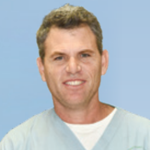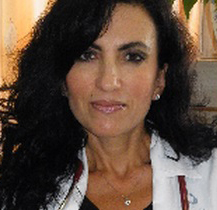The COVID-19 panedemic came as a storm. Physicians from multiple specialties are recruited to work in the front lines, and since most are not familiar with lung ultrasound, improving their scanning skills quickly and efficiently was crucial.
THE CHALLENGE
Since December 2019, the entire world is facing the outbreak of COVID-19 pandemic. The novel coronavirus infection causes acute lung inflammation, presented as pneumonia, pulmonary edema and Acute Respiratory Distress Syndrome (ARDS).
Due to the contamination risk, physicians cannot perform a physical examination with their stethoscopes, which is needed to evaluate lung condition. In addition, CT scan imaging that is usually used in similar lung disease requires patient transport, endangering the hospital patients and staff.
A tool was needed to enable physical examination and imaging to quickly evaluate the condition of COVID-19 patients at bedside.

Dr. Lior Fuchs, senior IICU physician at the Soroka Medical Center and member of staff in Ben-Gurion University Medical School, Be’er Sheva, Israel said, “From evidence collected in China and Italy, the use of lung ultrasound provides an alternative to a more accurate physical examination which can identify the disease in its early stages and understand which patients are in danger, without risking the protection of medical staff. Lung ultrasound examination at the bedside has become a critical part of the diagnostic protocol in COVID-19 patients.”
In comparison to lung CT, point-of-care lung ultrasound is safe, radiation free, low cost, and allows bedside scanning of patients, even when they are ventilated.
The pandemic came as a storm, creating burdens in hospitals around the world. Physicians from multiple specialties are recruited to work in the front lines, and since most are not familiar with lung ultrasound, improving their scanning skills quickly and efficiently was crucial.
THE SOLUTION
3D Systems’ R&D and product management teams worked around the clock to develop the COVID-19 module for the Simbionix U/S Mentor in order to provide focused training for physicians with various levels of experience in lung ultrasound. The new module includes a few case scenarios of coronavirus patients with typical ultrasound findings, from suspected patient to severe, as well as training videos. The training simulation was developed in collaboration with ICU and Critical Care physicians around the world.
Dr. Fuchs, who is also leading the point-of-care ultrasound training at the BGU medical school, trained his students using the Simbionix U/S Mentor. He initiated the Lung Ultrasound Simulation Mobile unit, operated by 6th year medical students. The students travel with the U/S Mentor simulator between hospitals across Israel and train medical staff to perform lung ultrasound and identify the manifestations of COVID-19 patients. This way, physicians can improve their skills so that in real time they will be able to reliably assess their patients.
U/S Mentor COVID-19 Mobile
U/S Mentor COVID-19 Module
THE ADVANTAGE
Multiple teams have already been trained and the mobile unit calendar is filled by hospital requests for training.
U/S COVID-19 Module being trained

Dr. Irina Bergman: ‘”We were required to open COVID-19 departments in all hospitals in Israel. We understood that we needed a different tool to perform an assessment. I gathered teams from different specialties: pulmonologists, anesthesiologists, internists, rheumatologists and even gastroenterologists that attended the training. It was wonderful, the instruction, the videos we received and also the simulation on a live volunteer from the group and on the simulator. We learned what we needed training in a short period of time.
Practicing on the simulator was great, since we were ready for the patients that we were going to meet. It was very tangible, and we learned what we were supposed to see and how to identify it.
All participants in the training were not radiologists by training so it is a very new experience for us. Until now we, internists had ultrasound experience with VScan, a small portable ultrasound unit to identify abdominal fluid and pleural fluid to help us perform a centesis by needle puncture. With simulation training we broadened our ultrasound knowledge and skills.
We feel more confident ready for the patients that we are going to meet. COVID-19 brought us into a new era in medicine which we did not know how to handle until now. We communicate with patients via video conference. Those who are in severe conditions, perhaps they are anesthetized and ventilated, it is not possible to communicate with them and we cannot perform physical examination until now. Diagnosis becomes more difficult and bringing a CT and chest X-ray is a complex procedure due to the PPE and disinfection protocols and the danger of spreading the contamination.
Therefore, we were extremely satisfied by this training. I think it is very important. We appreciate that it was conducted in a way that was very professional and educational. This was supported by the very good feedback that was shared by my team.”